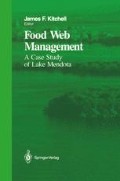Abstract
Lake Mendota is located near Madison (Dane County) in south central Wisconsin, USA (43°6′N, 89°24′W). It is the uppermost lake in the Yahara River chain of lakes, which also include Lakes Monona, Waubesa, and Kegonsa (Figure 3.1; Plate 2). After leaving Lake Kegonsa, the Yahara River drains south to the Rock River, which is tributary to the Missisippi River.
Access this chapter
Tax calculation will be finalised at checkout
Purchases are for personal use only
Preview
Unable to display preview. Download preview PDF.
References
Birge EA, Juday C (1911) The inland lakes of Wisconsin: The dissolved gases of the water and their biological significance. Bull. No. 22. Madison: Wis. Geol. Nat. Hist. Surv.
Brock TD (1985) A eutrophic lake: Lake Mendota, Wisconsin (Ecol. Stud. Vol. 55). Springer-Verlag, New York
Cline DR (1965) Geology and groundwater resources of Dane County, Wisconsin. Water Supply Pap. No. 1779-U. U.S. Geol. Surv., Washington
Delfino JJ (1968) Aqueous environmental chemistry of manganese. Ph.D. Thesis, University of Wisconsin, Madison
Hawley JE (1967) Calcium carbonate equilibrium in Lake Mendota. M.S. Thesis, University of Wisconsin, Madison
Holdren GC (1977) Factors affecting phosphorus release from lake sediments. Ph.D. Thesis, University of Wisconsin, Madison
Hurley JP (1988) Diagenesis of algal pigments in lake sediments. Ph.D. Thesis, University of Wisconsin, Madison
Ingvorsen K, Brock TD (1982) Electron flow via sulfate reduction and methanogenesis in the anaerobic hypolimnion of Lake Mendota. Limnol. Oceanogr. 27:559–564
Kanneberg A (1936) The dam at the outlet of Lake Mendota. In Lake Mendota: Origin and history, The Technical Club of Madison, Madison, Wisconsin, pp 17–19
Lathrop RC (1979) Appendix H: Lake management. In Dane County water quality plan, Vol. 2, Dane County Regional Planning Commission, Madison, Wisconsin, pp H–1–H–77
Lathrop RC (1988) Chloride and sodium trends in the Yahara lakes. Res. Manage. Find. No. 12. Wisconsin Department of Natural Resources, Madison
Lathrop RC (1990) Response of Lake Mendota (Wisconsin, U.S.A.) to decreased phosphorus loadings and the effect on downstream lakes. Verh. Int. Verein. Limnol. 24:457–463
Lathrop RC, Nehls SH, Brynildson CL, Plass KR (1992) The fishery of the Yahara lakes. Technical Bulletin (in press), Wisconsin Department of Natural Resources, Madison
Lee GF (1962) Studies on the iron, manganese, sulfate and silica balances and distributions for Lake Mendota, Madison, Wisconsin. Trans. Wis. Acad. Sci. Arts Lett. 51:141–155
Martin L (1965) The Physical Geography of Wisconsin. University of Wisconsin Press, Madison
National Oceanic and Atmospheric Administration (1988) Local climatological data: Annual summary with comparative data Madison, Wisconsin. Environ. Data and Inf. Serv., Natl. Clim. Cent., Asheville, North Carolina.
Robertson DM (1989) The use of lake water temperature and ice cover as climatic indicators. Ph.D. Thesis, University of Wisconsin, Madison
Sonzogni WC (1974) Effect of nutrient input reduction on the eutrophication of the Madison lakes. Ph.D. Thesis, University of Wisconsin, Madison
Stauffer RE (1974) Thermocline migration: Algal bloom relationships in stratified lakes. Ph.D. Thesis, University of Wisconsin, Madison
Stauffer RE (1987) A comparative analysis of iron, manganese, silica, phosphorus, and sulphur in the hypolimnia of calcareous lakes. Water Res. 21: 1009–1022
Stauffer RE, Lee GF (1973) The role of thermocline migration in regulating algal blooms. In Middlebrooks EJ, Falkenborg DH, Maloney TE (eds) Modeling the eutrophication process, Ann Arbor Science, Ann Arbor, Michigan, pp 73–82
Stewart KW (1976) Oxygen deficits, clarity, and eutrophication in some Madison lakes. Int. Rev. Ges. Hydrobiol. 61:563–579
Editor information
Editors and Affiliations
Rights and permissions
Copyright information
© 1992 Springer-Verlag New York Inc.
About this chapter
Cite this chapter
Lathrop, R.C. (1992). Lake Mendota and the Yahara River Chain. In: Kitchell, J.F. (eds) Food Web Management. Springer Series on Environmental Management. Springer, New York, NY. https://doi.org/10.1007/978-1-4612-4410-3_3
Download citation
DOI: https://doi.org/10.1007/978-1-4612-4410-3_3
Publisher Name: Springer, New York, NY
Print ISBN: 978-1-4612-8760-5
Online ISBN: 978-1-4612-4410-3
eBook Packages: Springer Book Archive

